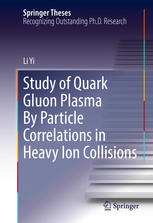

Most ebook files are in PDF format, so you can easily read them using various software such as Foxit Reader or directly on the Google Chrome browser.
Some ebook files are released by publishers in other formats such as .awz, .mobi, .epub, .fb2, etc. You may need to install specific software to read these formats on mobile/PC, such as Calibre.
Please read the tutorial at this link: https://ebookbell.com/faq
We offer FREE conversion to the popular formats you request; however, this may take some time. Therefore, right after payment, please email us, and we will try to provide the service as quickly as possible.
For some exceptional file formats or broken links (if any), please refrain from opening any disputes. Instead, email us first, and we will try to assist within a maximum of 6 hours.
EbookBell Team

5.0
20 reviewsThis thesis covers several important topics relevant to our understanding of quark-gluon plasma. It describes measurement of the third-order harmonic flow using two-particle correlations and isolation of flow and non-flow contributions to particle correlations in gold-gold collisions. The work also investigates long-range longitudinal correlations in small systems of deuteron-gold collisions. The former is related to the hydrodynamic transport properties of the quark-gluon plasma created in gold-gold collisions. The latter pertains to the question whether hydrodynamics is applicable to small systems, such as deuteron-gold collisions, and whether the quark-gluon plasma can be formed in those small-system collisions.
The work presented in this thesis was conducted with the STAR experiment at the Relativistic Heavy Ion Collider at Brookhaven National Laboratory, where the center-of-mass energy of both collision systems was a factor of 100 larger than the rest mass of the colliding nuclei. The results contained in this thesis are highly relevant to our quest for deeper understanding of quantum chromodynamics. The results obtained challenge the interpretation of previous works from several other experiments on small systems, and provoke a fresh look at the physics of hydrodynamics and particle correlations pertinent to high energy nuclear collisions.